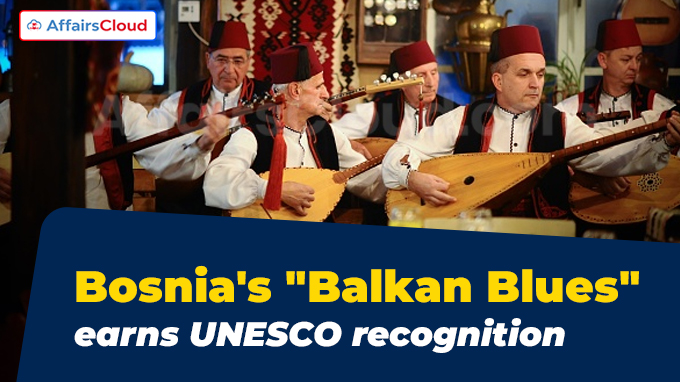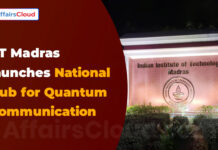 In December 2024, Sevdalinka, a melancholic and ancient love song from Bosnia and Herzegovina, was added to United Nations Educational, Scientific and Cultural Organization(UNESCO’s) National Inventory of Intangible Cultural Heritage (ICH). This recognition ensures that the tradition is safeguarded and celebrated as a vital cultural asset and contributes to its global appeal.
In December 2024, Sevdalinka, a melancholic and ancient love song from Bosnia and Herzegovina, was added to United Nations Educational, Scientific and Cultural Organization(UNESCO’s) National Inventory of Intangible Cultural Heritage (ICH). This recognition ensures that the tradition is safeguarded and celebrated as a vital cultural asset and contributes to its global appeal.
- The song dates back to the 16th century, referred to as the ‘Balkan blues’ due to its emotional depth and soulful melodies.
What is Sevdalinka?
i.Sevdalinka, often referred to as the “Balkan Blues,” is a traditional form of South Slavic music originating from Bosnia and Herzegovina.
- Sevdalinka blends South Slavic oral poetry with the musical influences of the Ottoman Empire.
ii.The song has been passed down through generations and was typically performed either a capella or by traditional instruments like the saz, a long-necked lute integral to Ottoman classical music.
iii.Damir Imamovic: A leading figure in the Sevdalinka revival who got several awards for his creations such as the European Best Album awarded by Songlines and the Transglobal Music magazines for the 2020/2021 period.
- His educational project, SevdahLab, serves to share Sevdalinka’s profound cultural legacy worldwide.
Key Practitioners:
- Enes Salman, a prominent folk singer, has been singing Sevdalinka since he was 14 and continues to promote the art form.
- Zanin Berbić, a music researcher and curator of the Sarajevo Regional Museum, plays a critical role in preserving and teaching Sevdalinka.
About Intangible Cultural Heritage (ICH):
i.ICH means the practices, representations, expressions, knowledge and skills that communities, groups and individuals recognize as a part of their cultural heritage.
- It also includes instruments, objects, artifacts and cultural spaces associated with such heritage.
ii.According to UNESCO’s 2003 Convention for the Safeguarding of the Intangible Cultural Heritage, ICH is manifested into 5 broad domains:
- Oral traditions and expressions, including language as a vehicle of the intangible cultural heritage, Performing arts, Social practices, rituals and festive events, Knowledge and practices concerning nature and the universe and Traditional craftsmanship.
India’s Intangible Cultural Heritage (ICH) list:
As of December 2024, India has 15 ICH elements on the UNESCO’s Representative List of ICH of Humanity.
| S.No | Intangible Cultural Heritage Element | Year of Inscription |
|---|---|---|
| 1 | Nawrouz | 2024 |
| 2 | Garba of Gujarat | 2023 |
| 3 | Durga Puja in Kolkata, West Bengal(WB) | 2021 |
| 4 | Kumbh Mela | 2017 |
| 5 | Yoga | 2016 |
| 6 | Traditional Brass and Copper Craft of Utensil Making among the Thatheras of Jandiala Guru, Punjab | 2014 |
| 7 | Sankirtana, ritual singing, drumming and dancing of Manipur | 2013 |
| 8 | Buddhist Chanting of Ladakh: Recitation of Sacred Buddhist Texts in the Trans-Himalayan Ladakh region, Jammu and Kashmir, India | 2012 |
| 9 | Mudiyettu, Ritual Theatre and Dance Drama of Kerala | 2010 |
| 10 | Kalbelia Folk Songs and Dances of Rajasthan | 2010 |
| 11 | Chhau Dance | 2010 |
| 12 | Ramman, Religious Festival and Ritual Theatre of the Garhwal Himalayas, India | 2009 |
| 13 | Ramlila, the Traditional Performance of the Ramayana | 2008 |
| 14 | Tradition of Vedic Chanting | 2008 |
| 15 | Kutiyattam, Sanskrit Theater | 2008 |
Note: The Sangeet Natak Akademi, under the Ministry of Culture(MoC), manages intangible cultural heritage.
About Bosnia and Herzegovina:
Prime Minister(PM)– Nermin Nikšić
Capital- Sarajevo
Currency- Bosnia-Herzegovina Convertible Mark (BAM)




